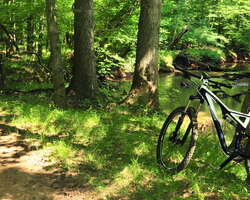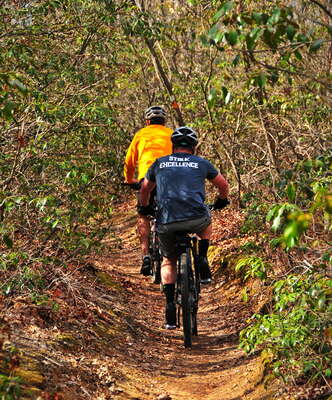
Mountain biking is an exhilarating outdoor activity that combines the thrill of cycling with the beauty of nature. It’s perfect for adrenaline seekers and fitness enthusiasts alike, offering a fantastic way to explore off-road trails and challenging terrains. Beyond the excitement, mountain biking provides numerous health benefits, including improved cardiovascular health, muscle strength, and mental well-being.
This article will cover..
In this article, we’ll guide you through the essentials of mountain biking. We’ll cover how to get started, the basic equipment you’ll need, the difference between entry-level and advanced gear, tips for your first ride, and fun activities to do while mountain biking.
Starting with mountain biking is easier than you might think. Begin by finding local trails suitable for beginners. These trails are usually marked as "green" or "easy" and have gentle slopes and minimal obstacles. Many parks and nature reserves offer well-maintained trails perfect for newcomers. Additionally, consider joining a local mountain biking group or club to get tips and find riding buddies.
To help you get familiar with mountain biking, here are some common terms you might encounter:
- Singletrack: A narrow trail designed for one-way bike traffic.
- Switchback: A sharp turn on a trail that zigzags up or down a hill.
- Berm: A banked turn on a trail.
- Drop: A steep descent where the trail drops off suddenly.
- Rock Garden: A section of trail filled with rocks, requiring careful navigation.
- Technical: Refers to challenging sections of a trail that require skillful riding.
- Line: The path or route a rider chooses to take on a trail.
- Full-Suspension: A bike with both front and rear suspension.
- Hardtail: A bike with front suspension only.
- Clipless Pedals: Pedals that require special shoes that clip into them for better control.
To get started, you’ll need some basic equipment:
- Mountain Bike: Look for a bike designed for trail riding with good suspension and sturdy tires.
- Helmet: Safety first! A well-fitting helmet is crucial.
- Gloves: Padded gloves can help with grip and reduce hand fatigue.
- Water Bottle or Hydration Pack: Stay hydrated on the trails.
- Basic Repair Kit: Includes a spare tube, tire levers, and a mini pump.
- Comfortable Clothing: Wear moisture-wicking and breathable clothes suitable for cycling.
Types of mountain bikes
- Hardtail Bikes: Equipped with front suspension only, hardtail bikes are lighter and more efficient for climbing and less technical trails.
- Full-Suspension Bikes: Featuring both front and rear suspension, full-suspension bikes offer greater comfort and control on rough and technical terrains.
- Cross Country (XC) Bikes: Designed for speed and endurance on smoother trails, cross country bikes are lightweight with efficient climbing capabilities.
- All-Mountain (Enduro) Bikes: Built for aggressive riding on challenging terrain, all-mountain bikes have more suspension travel for better control on steep descents.
- Downhill Bikes: Specifically designed for steep, fast descents, downhill bikes have long suspension travel, robust frames, and are heavier for added stability.
- Fat Bikes: Equipped with extra-wide tires, fat bikes provide excellent traction on snow, sand, and loose terrain, making them ideal for riding in challenging conditions.
- Electric Mountain Bikes (E-MTBs): Featuring an electric motor to assist with pedaling, e-MTBs allow riders to tackle more difficult climbs and longer rides with ease.
- Single-Speed Bikes: These bikes have only one gear, making them simpler and lighter. They are best suited for riders who prefer a straightforward, low-maintenance bike for smooth trails.

Transporting your mountain bike and gear to the trailhead is an important consideration:
- Bike Racks: Various types of bike racks are available, including trunk-mounted, hitch-mounted, and roof-mounted racks. Hitch-mounted racks are generally the easiest to use and can carry multiple bikes.
- Roof Racks: Secure the bike by the front fork or by both wheels. These racks provide stable transport but can be challenging to load and unload.
- Trunk-Mounted Racks: Affordable and easy to install, these racks use straps to secure the bike to the back of the car. They are suitable for lighter bikes.
- Tailgate Pads: Ideal for pickup trucks, tailgate pads allow you to drape bikes over the tailgate with padding to protect the frame.
- Interior Mounts: If you have a large vehicle, you might be able to transport your bike inside using interior bike mounts or simply by folding down seats.
- Gear Bags: Use gear bags or totes to organize and transport your helmet, gloves, repair kit, and hydration pack.
As you progress, you might want to upgrade your gear:
- Entry-Level: Basic mountain bikes, standard helmets, and simple repair kits.
- Depending on our budget, we always recommend going to a bike shop rather than Walmart or Target. Though it may cost a little more for an entry level bike, the components will be much stronger going to a real shop.
- Advanced: Full-suspension bikes, high-end helmets with more features, advanced repair kits, and specialized biking apparel.
- Higher quality bikes come with a higher pricetag, but will give you MUCH better equipment. It is lighter, stronger, and will need less maintenance of its lifespan.
For your first mountain biking adventure:
- Choose an easy trail and take it slow.
- Check your bike and gear before heading out.
- Start with a warm-up and stretch to avoid injuries.
- Pay attention to trail markers and follow the designated path.
- Take breaks as needed and enjoy the scenery.
- Learn Basic Skills: Practice braking, shifting gears, and riding over small obstacles.
- Stay Relaxed: Keep your body loose to better absorb shocks from the trail.
- Look Ahead: Focus on the trail ahead to anticipate obstacles.
- Balance: Keep a low center of gravity and use your body to maintain balance.
- Safety First: Always wear your helmet and be aware of your surroundings.
- Explore New Trails: Discover different trails and enjoy various terrains.
- Join a Group Ride: Meet new people and learn from experienced riders.
- Trailside Picnic: Pack a small snack and take a break in a scenic spot.
- Photography: Capture the beautiful landscapes you encounter.
- Trail Maintenance: Participate in trail clean-up or maintenance days to give back to the community.
Mountain biking is excellent for your health, offering a full-body workout that enhances cardiovascular fitness, builds muscle strength, and improves balance and coordination. The mental benefits are just as significant, with the combination of physical exercise and time spent in nature helping to reduce stress and boost mood.
Wrapping Things Up

Mountain biking is a thrilling way to stay fit, explore nature, and challenge yourself. By starting with the right gear and gradually improving your skills, you’ll soon be tackling more challenging trails with confidence. So gear up, hit the trails, and experience the excitement of mountain biking!



Post Comments